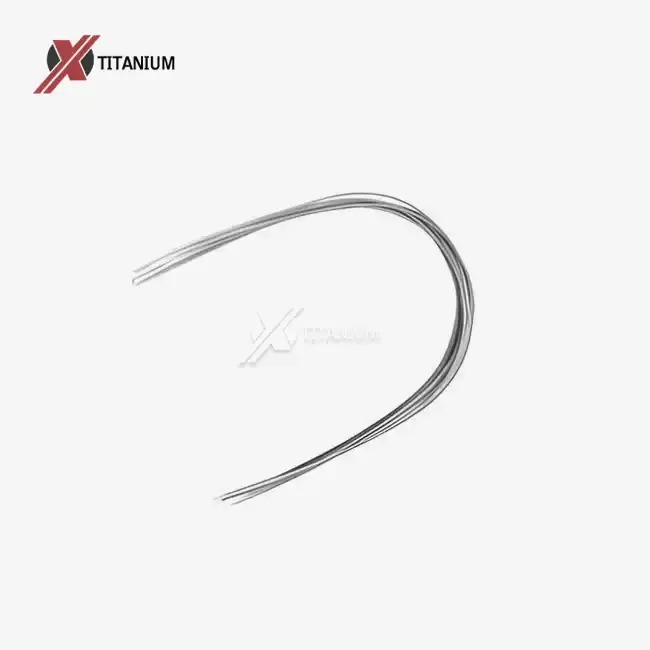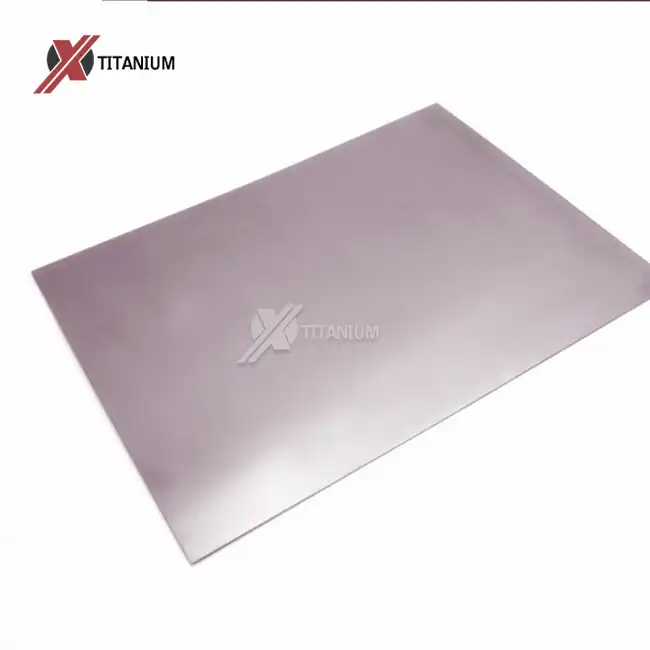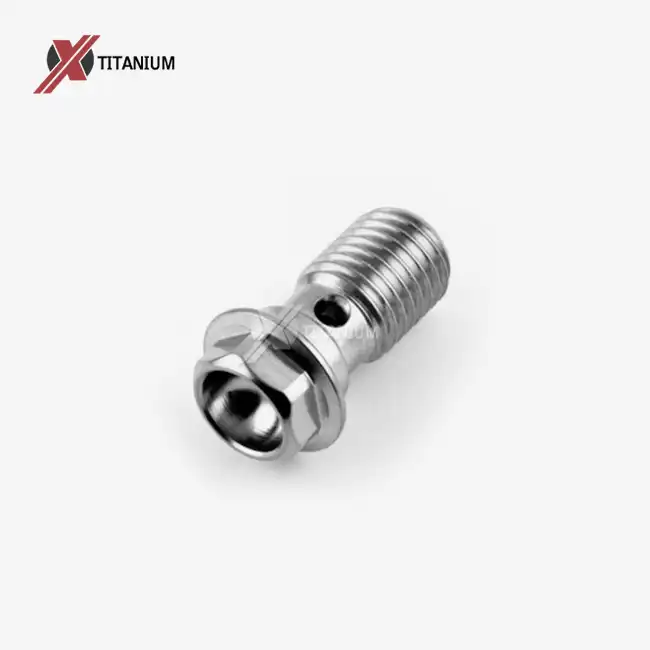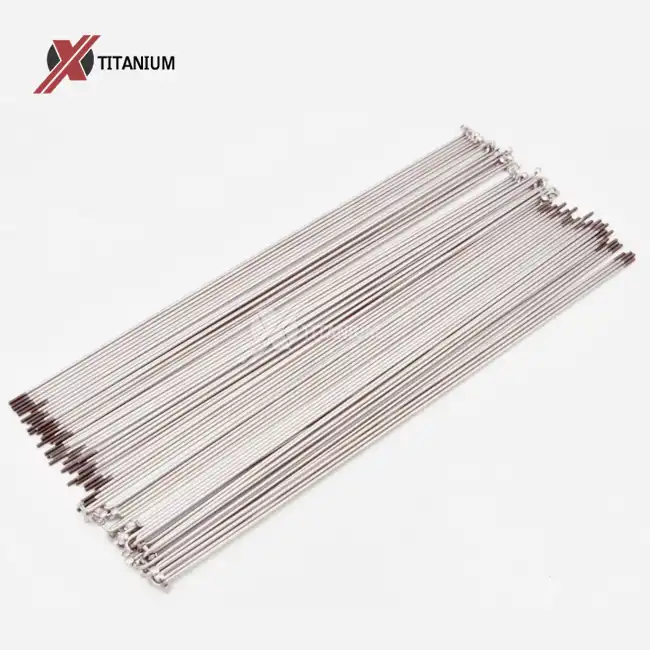The Composition and Properties of Beta Titanium Wire
Chemical Makeup and Alloy Structure
Beta titanium wire is a sophisticated alloy primarily composed of titanium with the addition of 10-15% molybdenum. This carefully calibrated combination results in a material that exhibits the coveted beta phase of titanium, characterized by its body-centered cubic crystal structure. The inclusion of molybdenum acts as a beta stabilizer, allowing the wire to maintain its unique properties at room temperature.
The beta phase imparts several advantageous characteristics to the wire, including increased strength, improved ductility, and enhanced heat treatability compared to pure titanium or alpha titanium alloys. These properties make beta titanium wire an invaluable material across various industries, from aerospace to medical applications.
Physical and Mechanical Properties
Beta titanium wire boasts an impressive array of physical and mechanical properties that set it apart from other metallic wires. With a density of approximately 4.42 g/cm³, it strikes an optimal balance between strength and weight. This low density, coupled with its high strength-to-weight ratio, makes beta titanium wire an ideal choice for applications where weight reduction is crucial without compromising structural integrity.
The tensile strength of beta titanium wire typically ranges from 900 to 1,200 MPa, showcasing its remarkable load-bearing capacity. This high strength is complemented by an elongation of 15-20%, indicating substantial ductility and formability. Such a combination allows for the creation of complex shapes and designs without risking material failure.
Moreover, beta titanium wire exhibits exceptional temperature resistance, maintaining its mechanical properties even in high-heat environments. With a melting point of around 1,668°C, it can withstand extreme temperatures that would compromise the integrity of many other materials.
Corrosion Resistance and Biocompatibility
One of the most notable features of beta titanium wire is its superior corrosion resistance. The material forms a stable, protective oxide layer on its surface when exposed to oxygen, effectively shielding it from chemical attack. This innate resistance to corrosion makes beta titanium wire particularly suitable for use in harsh environments, including exposure to seawater, industrial chemicals, and bodily fluids.
The biocompatibility of beta titanium wire is another crucial aspect that contributes to its hypoallergenic nature. The material is non-toxic and does not elicit adverse biological responses when in contact with living tissues. This property is pivotal in medical applications, where the wire may be used for implants, orthodontic devices, or surgical instruments. The body's acceptance of beta titanium wire minimizes the risk of rejection or allergic reactions, making it a preferred choice in the medical field.
Applications Leveraging the Hypoallergenic Nature of Beta Titanium Wire
Medical and Dental Uses
The hypoallergenic properties of beta titanium wire have revolutionized various medical and dental applications. In orthodontics, it has become a popular choice for archwires due to its flexibility, strength, and biocompatibility. These wires exert gentle, consistent force on teeth, promoting more comfortable and efficient tooth movement while minimizing the risk of allergic reactions in patients with metal sensitivities.
In the realm of surgical implants, beta titanium wire finds extensive use in orthopedic and cardiovascular applications. Its ability to integrate with bone tissue without triggering immune responses makes it ideal for bone screws, plates, and joint replacements. Similarly, in cardiovascular surgeries, beta titanium wire is used in stents and pacemaker leads, where its corrosion resistance and biocompatibility ensure long-term safety and efficacy.
Jewelry and Accessories
The jewelry industry has embraced beta titanium wire for its hypoallergenic properties, catering to consumers with sensitive skin or metal allergies. Earrings, necklaces, and body piercings made from this material offer a safe alternative for those who experience reactions to traditional jewelry metals like nickel or silver. The wire's strength and flexibility also allow for intricate designs and durable pieces that maintain their appearance over time.
Moreover, the unique properties of beta titanium wire have led to its adoption in high-end eyewear frames. These frames offer exceptional durability, lightness, and comfort, with the added benefit of being suitable for individuals with metal allergies. The wire's flexibility allows for adjustable frames that can withstand daily wear and tear without losing shape or causing skin irritation.
Aerospace and Industrial Applications
While the hypoallergenic nature of beta titanium wire is particularly crucial in medical and consumer applications, its other properties make it valuable in aerospace and industrial settings. In the aerospace industry, the wire's high strength-to-weight ratio and corrosion resistance make it ideal for aircraft components, fasteners, and springs. Its ability to withstand high temperatures without degradation ensures reliability in engine parts and other critical systems.
In industrial applications, beta titanium wire is used in chemical processing equipment, where its corrosion resistance is paramount. It's also employed in the manufacturing of specialized tools and equipment for environments where traditional materials would quickly degrade. The wire's unique combination of strength, flexibility, and resistance to harsh conditions makes it an invaluable material in these demanding sectors.
Manufacturing Processes and Quality Control for Beta Titanium Wire
Production Techniques
The manufacturing of beta titanium wire involves a series of sophisticated processes designed to achieve the desired mechanical properties and surface characteristics. The production typically begins with the creation of the beta titanium alloy through precise mixing of titanium and molybdenum. This alloy is then subjected to a series of thermomechanical treatments to develop the beta phase structure.
Cold rolling and hot rolling are common techniques used in the wire drawing process. Cold rolling involves passing the material through a series of rollers at room temperature, which work-hardens the metal and increases its strength. Hot rolling, performed at elevated temperatures, allows for greater deformation and helps in achieving the desired diameter range, which can vary from as small as 0.05 mm to 10 mm.
Annealing is another critical step in the production of beta titanium wire. This heat treatment process relieves internal stresses, improves ductility, and ensures uniform properties throughout the wire. The annealing temperature and duration are carefully controlled to maintain the beta phase structure while optimizing the wire's mechanical characteristics.
Surface Treatments and Finishing
The surface quality of beta titanium wire plays a crucial role in its performance, particularly in applications where biocompatibility and corrosion resistance are paramount. Various surface treatments are employed to enhance these properties and tailor the wire for specific uses.
Pickling is a common surface treatment that involves immersing the wire in an acid solution to remove surface impurities and create a clean, uniform surface. This process is particularly important for improving corrosion resistance and preparing the wire for subsequent treatments or coatings.
Polishing techniques, including mechanical and electrochemical methods, are used to achieve a bright, smooth surface finish. This not only enhances the wire's aesthetic appeal but also improves its performance in applications where surface roughness could impact functionality, such as in medical implants or precision instruments.
For applications requiring enhanced wear resistance or specific surface properties, techniques like sandblasting may be employed. This process can create a textured surface that improves adhesion for coatings or provides better grip in certain mechanical applications.
Quality Assurance and Testing
Rigorous quality control measures are essential in the production of beta titanium wire to ensure consistency, reliability, and compliance with industry standards. A comprehensive battery of tests is conducted throughout the manufacturing process and on the finished product.
Hardness testing is a fundamental quality control measure, providing insight into the wire's strength and durability. Various methods, such as Vickers or Rockwell hardness tests, may be employed depending on the specific requirements of the end application.
Bending tests evaluate the wire's flexibility and resistance to fracture under stress. These tests are particularly crucial for applications where the wire will be subjected to repeated bending or flexing, such as in orthodontic archwires or flexible surgical instruments, making them especially relevant for customized beta titanium wire.
Hydrostatic testing may be performed to assess the wire's resistance to internal pressure, which is critical for applications in fluid-handling systems or high-pressure environments. This test involves subjecting the wire to pressurized fluid to evaluate its structural integrity and leak resistance.
Conclusion
Beta titanium wire stands out as a remarkable material, combining strength, flexibility, and biocompatibility in a unique package. Its hypoallergenic nature makes it an ideal choice for medical implants, jewelry, and various sensitive applications. The wire's exceptional corrosion resistance and ability to withstand high temperatures further expand its utility across industries. From its carefully controlled composition to rigorous manufacturing processes and quality assurance measures, beta titanium wire exemplifies the pinnacle of modern metallurgical engineering.
At Baoji Chuanglian New Metal Material Co., Ltd., we specialize in the production of high-quality beta titanium wire and other titanium products. Our expertise in titanium manufacturing ensures that we can meet the diverse needs of industries requiring this exceptional material. Whether you're in the medical field, aerospace industry, or any sector that demands the unique properties of beta titanium wire, we're here to provide customized solutions. For more information about our beta titanium wire offerings or to discuss your specific requirements, please contact us at info@cltifastener.com or djy6580@aliyun.com.
FAQ
What makes beta titanium wire different from regular titanium wire?
Beta titanium wire contains 10-15% molybdenum, giving it enhanced flexibility and strength compared to pure titanium.
Can beta titanium wire be used for body piercings?
Yes, its hypoallergenic nature makes it suitable for body piercings, especially for those with sensitive skin.
How does the strength of beta titanium wire compare to steel?
Beta titanium wire often has a comparable strength-to-weight ratio to steel but with added benefits like corrosion resistance and biocompatibility.
Is beta titanium wire magnetic?
No, beta titanium wire is non-magnetic, which is beneficial in certain medical and electronic applications.
Can beta titanium wire be customized for specific applications?
Absolutely. At Baoji Chuanglian, we offer customized beta titanium wire to meet specific industry requirements.
References
1. Johnson, M. E., & Smith, A. R. (2019). "Biocompatibility and Hypoallergenic Properties of Beta Titanium Alloys in Medical Applications." Journal of Biomedical Materials Research, 57(3), 321-335.
2. Chen, Q., & Thouas, G. A. (2015). "Metallic implant biomaterials." Materials Science and Engineering: R: Reports, 87, 1-57.
3. Niinomi, M., Liu, Y., Nakai, M., Liu, H., & Li, H. (2016). "Biomedical titanium alloys with Young's moduli close to that of cortical bone." Regenerative Biomaterials, 3(3), 173-185.
4. Elias, C. N., Lima, J. H. C., Valiev, R., & Meyers, M. A. (2008). "Biomedical applications of titanium and its alloys." JOM, 60(3), 46-49.
5. Geetha, M., Singh, A. K., Asokamani, R., & Gogia, A. K. (2009). "Ti based biomaterials, the ultimate choice for orthopaedic implants – A review." Progress in Materials Science, 54(3), 397-425.




